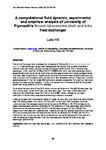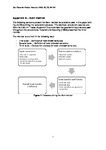A computational fluid dynamic, experimental and empirical analysis of University of Plymouth’s Brunel laboratories shell and tube heat exchanger
| dc.contributor.author | Hill, L. | |
| dc.date.accessioned | 2022-07-28T17:01:23Z | |
| dc.date.available | 2022-07-28T17:01:23Z | |
| dc.date.issued | 2022 | |
| dc.identifier.citation |
Hill, L. (2022) 'A computational fluid dynamic, experimental and empirical analysis of University of Plymouth’s Brunel laboratories shell and tube heat exchanger', The Plymouth Student Scientist, 15(1), pp. 69-103. | en_US |
| dc.identifier.uri | http://hdl.handle.net/10026.1/19457 | |
| dc.description.abstract |
The aim of this paper is to analyses the University of Plymouth’s Brunel laboratories shell and tube heat exchanger using three investigative methods aiming to determine which method most accurately predicts the heat exchanger performance. The university heat exchanger, UHX, uses the TECQUIPMENT TD360C shell and tube heat exchanger but an experimental study could not be conducted so data was collated from previous experiments. This was used to calculate an experimental value for the overall heat transfer coefficient (U). Two empirical methods were used, the Kern and Bell-Delaware method. These two methods were developed in the mid to late 20th century to provide a prediction for U without having to conduct an experimental analysis. Finally, a computational fluid dynamic (CFD), study was performed using ANSYS CFX CFD package. To validate the accuracy of the CFD model a study by Ozden and Tari (2010) was used. As their method was unclear CFD best practices were used. The major differences were changing the turbulence model from the k-ϵ to the SST model, increasing the mesh resolution in the boundary layers and conducting a transient analysis. It was concluded that the validation case CFD was not accurate, and the actual performance was 108-150% greater than theirs. For the UHX, the Kern and Bell-Delaware methods underpredicted the averaged experimental values by 73-76% and 46-77% Consequently, these methods were deemed insufficient for the prediction of heat exchanger performance. Compared to the validation case the CFD method was changed for the UHX with the modelling of the tubes and tubes volume. It was found that the parallel-flow and counter-flow CFD results overpredicted the experimental results by 16-30% and 18-36%. As the CFD method did not include any real-world problems such as baffle leakage and fluctuations in inlet temperature it was deemed to be the most accurate method for predicting heat exchanger performance. | en_US |
| dc.language.iso | en | en_US |
| dc.publisher | University of Plymouth | en_US |
| dc.rights | Attribution 3.0 United States | * |
| dc.rights.uri | http://creativecommons.org/licenses/by/3.0/us/ | * |
| dc.subject | Shell and tube heat exchanger | en_US |
| dc.subject | CFD | en_US |
| dc.subject | ANSYS CFX | en_US |
| dc.subject | Kern method | en_US |
| dc.subject | Bell-Delaware method | en_US |
| dc.title | A computational fluid dynamic, experimental and empirical analysis of University of Plymouth’s Brunel laboratories shell and tube heat exchanger | en_US |
| dc.type | Article | en_US |
| plymouth.issue | 1 | |
| plymouth.volume | 15 | |
| plymouth.journal | The Plymouth Student Scientist |




